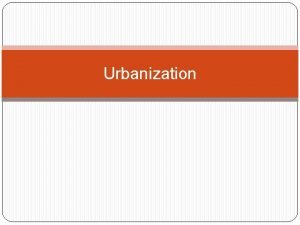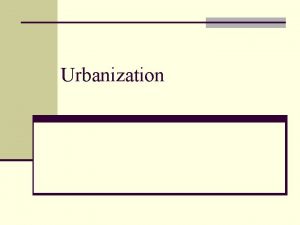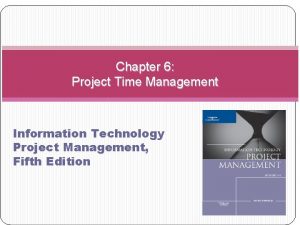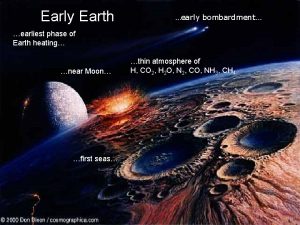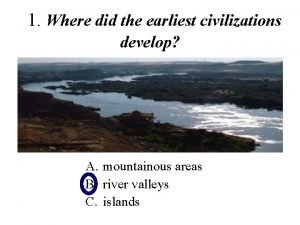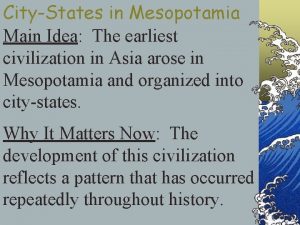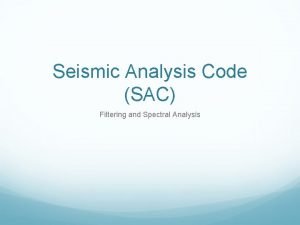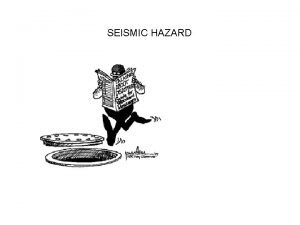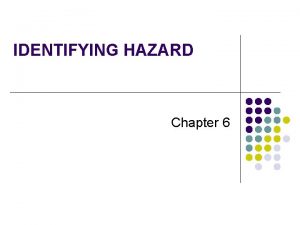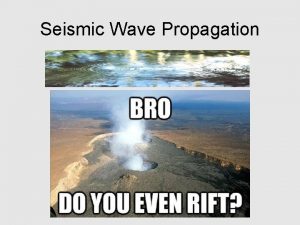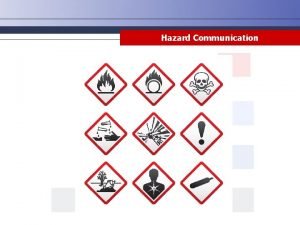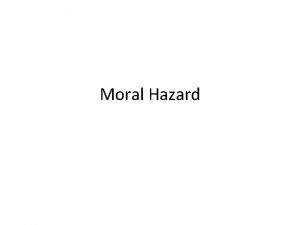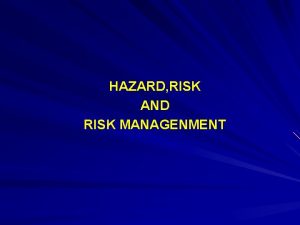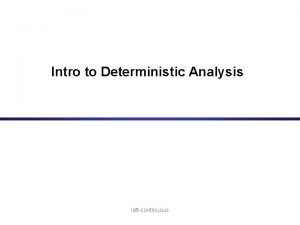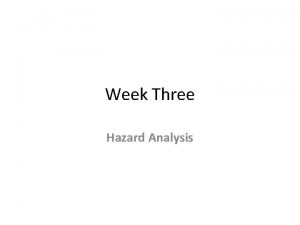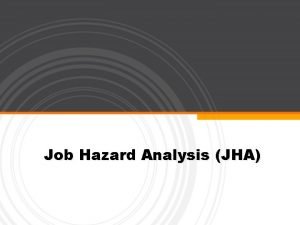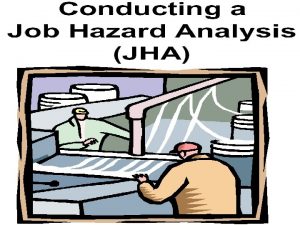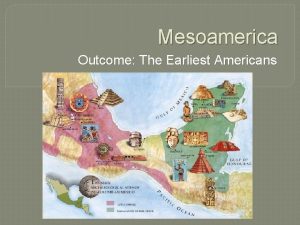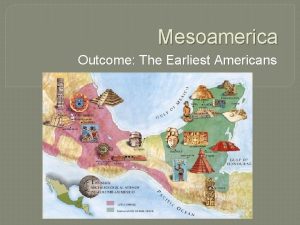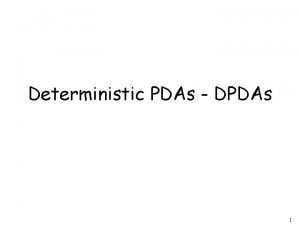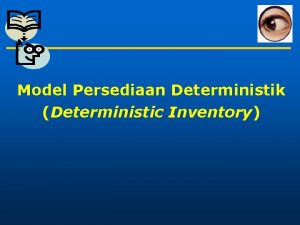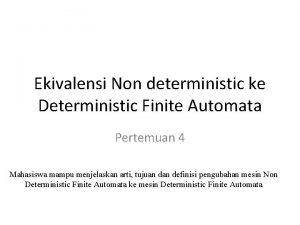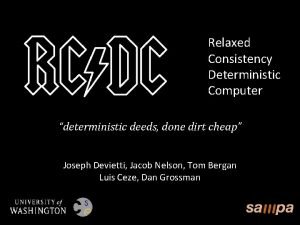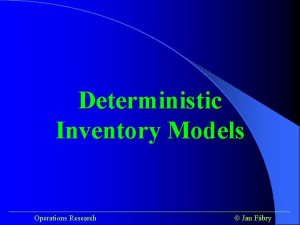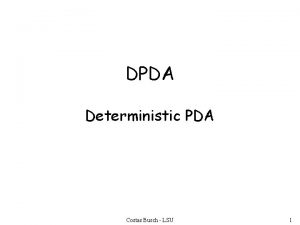Deterministic Seismic Hazard Analysis Earliest approach taken to
























- Slides: 24

Deterministic Seismic Hazard Analysis Earliest approach taken to seismic hazard analysis Originated in nuclear power industry applications Still used for some significant structures Nuclear power plants Large dams Large bridges Hazardous waste containment facilities As “cap” for probabilistic analyses

Deterministic Seismic Hazard Analysis Corps of Engineers Regulation 1110 -2 -1804 (1995) Sec. 5. h. 2. a Deterministic seismic hazard analysis (DSHA). The DSHA approach uses the known seismic sources sufficiently near the site and available historical seismic and geological data to generate discrete, single-valued events or models of ground motion at the site. Typically one or more earthquakes are specified by magnitude and location with respect to the site. Usually the earthquakes are assumed to occur on the portion of the site closest to the site. The site ground motions are estimated deterministically, given the magnitude, source-to-site distance, and site condition.

Deterministic Seismic Hazard Analysis Consists of four primary steps: 1. Identification and characterization of all sources 2. Selection of source-site distance parameter 3. Selection of “controlling earthquake” 4. Definition of hazard using controlling earthquake

Deterministic Seismic Hazard Analysis Identification and characterization of all sources Identification All sources capable of producing significant ground motion at the site Large sources at long distances Small sources at short distances Characterization Definition of source geometry Establishment of earthquake potential

Deterministic Seismic Hazard Analysis Identification and characterization of all sources Which sources are capable of producing significant motion at the site of interest? What is significant motion? Parametric definition Peak acceleration - usually ~0. 05 g Spectral acceleration - at fundamental period, if known Other parameters Use predictive (attenuation) relationship to determine distance of interest

Deterministic Seismic Hazard Analysis Identification and characterization of all sources Estimate maximum magnitude that could be produced by any source in vicinity of site Find value of Rmax - corresponds to Mmax at threshold value of parameter of interest, Ymin. ln Y M = Mmax Ymin Rmax log R

Deterministic Seismic Hazard Analysis Identification and characterization of all sources Characterize geometry Point source Constant source-site distance Volcanos, distant short faults Source Site Linear source One parameter controls distance Shallow, distant fault Source Site

Deterministic Seismic Hazard Analysis Identification and characterization of all sources Characterize geometry Areal source Two geometric parameters control distance Constant depth crustal source Site Source Volumetric source Three parameters control distance Site Source

Deterministic Seismic Hazard Analysis Identification and characterization of all sources Establish earthquake potential - typically Mmax Empirical correlations Rupture length correlations Rupture area correlations Maximum surface displacement correlations “Theoretical” determination Slip rate correlations

Deterministic Seismic Hazard Analysis Identification and characterization of all sources Slip rate approach Recall seismic moment Mo = m A D where m = shear modulus of rock A = rupture area D = average displacement over rupture area

Deterministic Seismic Hazard Analysis Identification and characterization of all sources Slip rate approach If average displacement relieves stress/strain built up by movement of the plates over some period, T, then D=Sx. T where S is the slip rate

Deterministic Seismic Hazard Analysis Identification and characterization of all sources Slip rate approach Then Mo = m A S T and the “moment rate” can be defined as Mo = Mo/T = m A S

Deterministic Seismic Hazard Analysis Identification and characterization of all sources Slip rate approach Knowing the slip rate and knowing (assuming) values of m, A, and T, the moment rate can be used to estimate the seismic moment as Mo = Mo T Then Mw = log Mo/1. 5 - 10. 7

Deterministic Seismic Hazard Analysis Select source-site distance parameter Define source-site distance Must be consistent with predictive relationship Should include finite fault effect Select source-site distance Distance to surface projection of closest point on rupture surface Distance to closest point on rupture surface Hypocentral distance Epicentral distance

Deterministic Seismic Hazard Analysis Select source-site distance parameter Distance measures Vertical Faults rjb rrup rseis rhypo Seismogenic depth

Deterministic Seismic Hazard Analysis Select source-site distance parameter Distance measures Dipping Faults rjb=0 rseis rrup r hypo rjb rseis & rrup rhypo

Deterministic Seismic Hazard Analysis Select source-site distance parameter Typically assume shortest source-site distance (“worst case” scenario) Rmin Source Point source Site Rmin Site Source Linear source

Deterministic Seismic Hazard Analysis Select source-site distance parameter Typically assume shortest source-site distance (“worst case” scenario) Site Rmin Areal source Source Rmin Site Source Volumetric source

Deterministic Seismic Hazard Analysis Select controlling earthquake Decision based on ground motion parameter(s) of greatest interest Consider all sources Assume Mmax occurs at Rmin for each source Compute ground motion parameter(s) based on Mmax and Rmin Determine critical value(s) of ground motion parameter(s)

Deterministic Seismic Hazard Analysis Select controlling earthquake Source 1 Source 3 R 1 M 1 R 2 R 3 M 2 Source 2 Site M 3

Deterministic Seismic Hazard Analysis Select controlling earthquake ln Y Y 2 Y 3 Y 1 M 2 Source 2 controls Combination of M 2 and R 2 produces highest value of Y M = M 1 M 3 R 2 R 3 R 1 log R

Deterministic Seismic Hazard Analysis Define hazard using controlling earthquake Peak acceleration Spectral accelerations ln amax Use M and R to determine such parameters as: Duration log R Sa 0 T

Deterministic Seismic Hazard Analysis Comments DSHA produces “scenario” earthquake for design (design earthquake) As commonly used, produces worst-case scenario DSHA provides no indication of how likely design earthquake is to occur during life of structure Design earthquakes may occur every 200 yrs in some places, every 10, 000 yrs in others DSHA can require subjective opinions on some input parameters Variability in effects not rationally accounted for

Deterministic Seismic Hazard Analysis Corps of Engineers Regulation 1110 -2 -1804 (1995) Sec. 5. h. 2. a Deterministic seismic hazard analysis (DSHA). The DSHA approach uses the known seismic sources sufficiently near the site and available historical seismic and geological data to generate discrete, single-valued events or models of ground motion DSHA calculations are relatively simple, but at the site. Typically one or more earthquakes are specified by implementation of procedure in practice involves magnitude and location with respect to the site. Usually the numerous difficult judgements. The lack of explicit earthquakes are assumed to occur on the portion of the site closest consideration of uncertainties should not be taken to to the site. The site ground motions are estimated deterministically, imply that those uncertainties do not exist. given the magnitude, source-to-site distance, and site condition.
 Deterministic seismic hazard analysis
Deterministic seismic hazard analysis Define urban hierarchy
Define urban hierarchy Earliest urban hearths
Earliest urban hearths The are our earliest literature
The are our earliest literature The earliest bridges consisted mainly of
The earliest bridges consisted mainly of Prometheus and hera
Prometheus and hera Lesson 6: chordate evolution and diversity
Lesson 6: chordate evolution and diversity Earliest urban hearths
Earliest urban hearths Earliest start time formula
Earliest start time formula This bring the first sorrow of rizal in calamba.
This bring the first sorrow of rizal in calamba. Pericles and the bull
Pericles and the bull Earliest form of tennis was called
Earliest form of tennis was called The earliest recorded activities in gymnastics
The earliest recorded activities in gymnastics The earliest fossils date back to about when?
The earliest fossils date back to about when? Earliest earth
Earliest earth Where did the earliest civilizations develop
Where did the earliest civilizations develop Disadvantages of transactional model of communication
Disadvantages of transactional model of communication Oldest genre
Oldest genre The earliest civilization in asia arose in
The earliest civilization in asia arose in The earliest texans lived in shelters made of wood.
The earliest texans lived in shelters made of wood. The earliest start time rule
The earliest start time rule The earliest aegean civilization was located
The earliest aegean civilization was located Boxcar proteomics
Boxcar proteomics Sac seismic
Sac seismic Non-deterministic algorithm
Non-deterministic algorithm

